Selection and decision criteria to get the best IoT platform or IoT-enabled business/industry edge platform for your current and future needs as edge capabilities become more important across industries and IoT use cases.
Edge computing brings data processing, analytical and computational capabilities closer to the edge of a network. In the case of an IoT network these are the so-called ‘things’.
The support of IoT edge (and fog computing capabilities) is one of the main trends in the IoT platform market. Even if edge computing in an IoT scope is evolving and still a bit ‘under construction’, the evolutions in several enterprise and industrial IoT segments increasingly require edge computing capabilities as an ‘environment’ or architecture where data can be accessed and analyzed fast when and where needed (de facto often in a hybrid way as it’s a mix of edge and cloud computing, potentially on-premises and also offline capabilities).
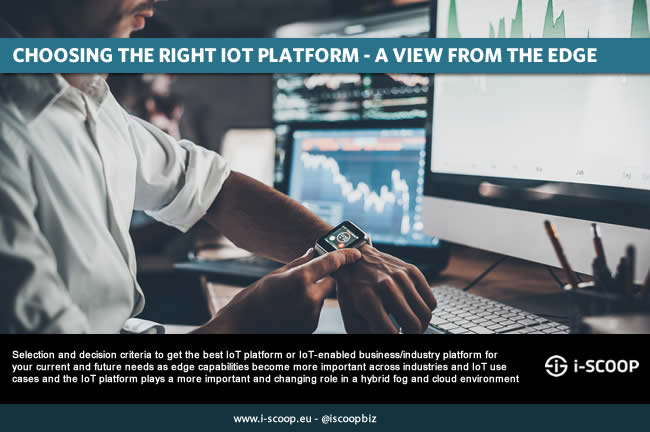
Edge computing isn’t of course needed for all IoT deployments or IoT data. However, as IoT projects mature and scale, ever more IoT use cases will require it. We are typically speaking about IoT use cases and larger IoT projects in the scope of Industrial IoT (manufacturing and industrial markets, automotive etc.), resources industries (e.g. energy, oil and gas, etc.), smart cities, supply chain and logistics IoT projects and Industry 4.0 applications.
In other words: in a scope of IoT platform selection it’s mainly about enterprise IoT platforms in several verticals, smart city IoT platforms and industrial IoT platforms for now. With these IoT platforms representing by far the largest portion of IoT platforms and being on the radar of most buyers the importance of edge capabilities becomes even higher in selecting the best IoT platform.
Why edge capabilities are important when selecting the best IoT platform for your (future) needs
Taking into account the typical circumstances where edge computing is important de facto most organizations are or soon will be confronted with the need for or benefits of edge capabilities.
Such conditions, circumstances and benefits include (a mix of):
- Many/critical devices/assets with lots of critical data to rapidly access, analyze and leverage;
- Use cases where the cost and latency of transmitting that data to a data center or the cloud is an issue;
- Critical applications and conditions where it’s key to filter, analyze and send specific data (which are turned into structured data) asap to the IoT cloud platform or other cloud systems, business applications and control systems because of the consequences if this is not done (critical equipment about to break down, urgent optimizations, speed as a competitive differentiator and must as in logistics and ample other examples depending on use case and industry);
- A higher level of security, at the edge, and more (in the overall IoT device lifecycle management scope, starting from onboarding/provisioning, encryption, authentication and data protection and in a distributed way whereby security is embedded ‘in the edge’);
- Lower costs and higher efficiency, both directly and indirectly (real-time decisions, storage and bandwidth, higher value remote and predictive use cases);
- Etc.
Picking the best edge platform – beyond the here and now
Industry analysts see a rise of edge computing for the mentioned reasons (with predictions often looking more at exactly how fast edge computing adoption will grow, rather than if it will be important).
Why does all this matter for many organizations in the market for an IoT platform?
First of all they look for the best IoT platform(s) that cover their individual needs in the here and now. In many industries that might mean the need for edge capabilities is already clear and present, for instance because of that need for speed and the mission-critical nature of specific data requiring fast analysis and interventions/decisions (e.g. in Industrial IoT where the ‘things’ at the edge can be IoT gateways, edge servers, critical assets and equipment, vehicle fleets in ample environments, industrial controllers in hard-to-reach places in resource industries, controllers, machines and sensors in factories, geographically dispersed IoT assets in urban environments, connected equipment in logistics, critical assets in healthcare facilities, the list goes on and, here as well, depends on industry and use case).
Secondly, organizations don’t start with IoT deployments and initiatives in all possible use cases and for all possible goals at once. It’s not as if a production environment becomes fully connected and automated in one big move (with perhaps the exception of Tesla, with all the known consequences).
Selecting the best IoT platform is not just a matter of the here and now . Organizations will typically move in a staged way, learn from experiences and add more applications and use cases as the next stage of IoT deployment arrives.
They will want to build applications (or have them built) as they progress (why an IoT platform needs application enablement at the core and why IoT-enabled business platforms allow it as well and must be able to seamlessly integrate with these applications). However, they will also generate more data and connect more things as is happening in organizations which are further ahead.
So, at one point or the other edge will pop up for a mix of reasons. And despite the fact that edge computing is still maturing several IoT platforms do offer edge/fog capabilities already now with some clear leaders. Since selecting the best IoT platform is usually not something that is done for the short term alone: edge intelligence is very important to consider.
In other words: in selecting the best IoT platform or IoT-enabled platform for your needs, the support of edge capabilities is a criterion as such.
This is already the case in myriad solutions across ample industries and use cases where pro-active maintenance, rapid actions, quick alerts and so forth matter a lot. Think about facility management and smart buildings and especially critical power buildings such as healthcare facilities, airports, industrial facilities, asset- and data-intensive facilities such as large public venues. Think about pretty much any serious smart city application (e.g. smart traffic and roads, public transport….). And of course there are all those industrial applications, logistics and so much more.
When choosing the best IoT platform for your needs look at your current and future needs that require edge capabilities, taking into account the several use cases of which many are relatively common for most organizations.
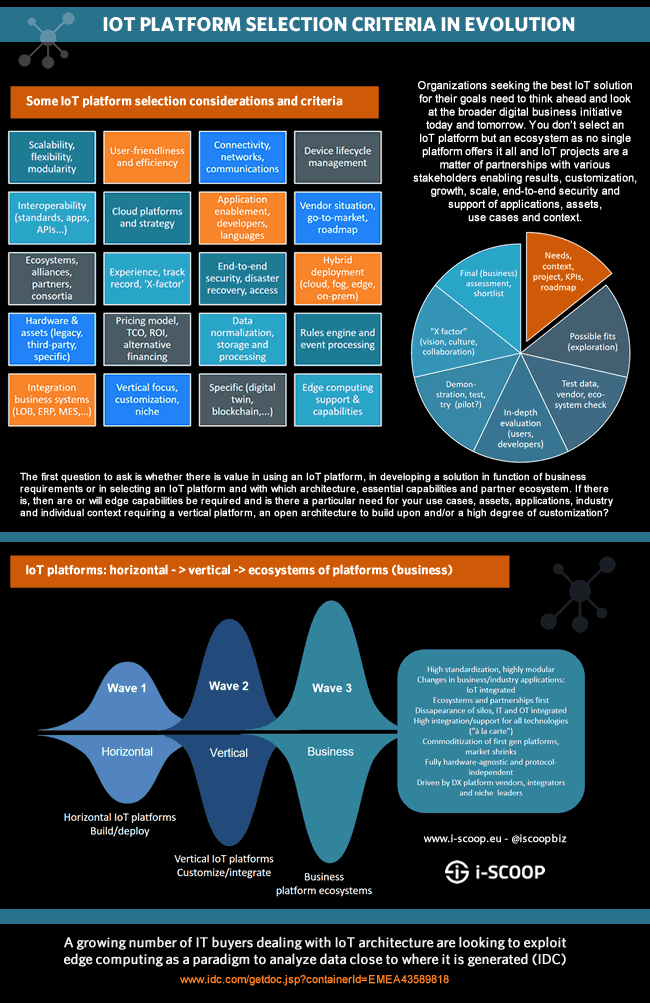
IoT edge platforms: where the edge fits in the IoT platform architecture
The selection of the best platform that supports edge capabilities obviously isn’t just about these edge functions as such (more about those below).
You also want to take general business and technology/growth considerations into account that apply when selecting the best IoT platform for your needs/ideas overall as we summed a few ones up in our IoT platform guide.
Edge capabilities are part of several performance parameters as depicted below in the IoT platform architecture model of MachNation, which runs the MachNation IoT platform test lab MIT-E, publishes the annual MachNation AEP ScoreCard and end 2017 released its first edge platform ScoreCard ever.
The device, edge and cloud levels are well illustrated and the colors used stand for IoT platform categories of performance parameters with capabilities (and criteria) regarding application (enablement), monitoring, access control, analytics, integration, device management, event processing and data management. Picking the best IoT platform will depend on the performance in executing tasks on the several architectural components and their importance on a deeper level within the scope of your goals, needs and context too.
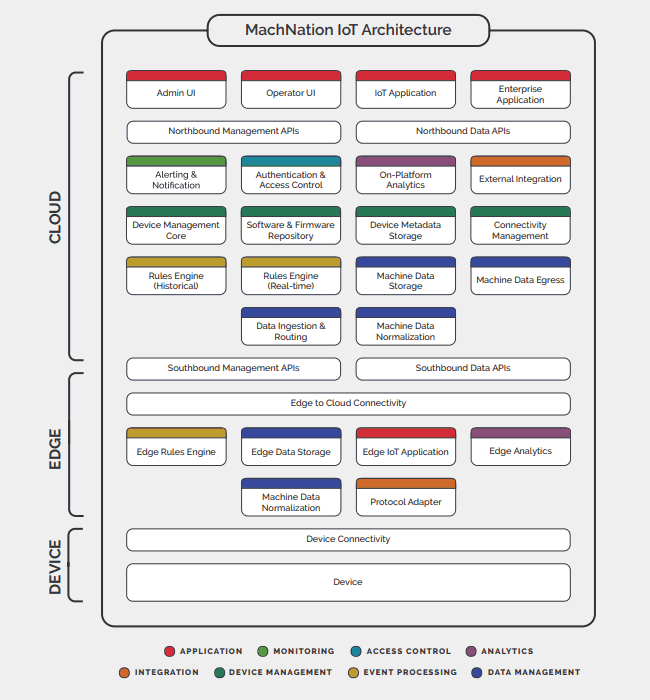
Selection criteria met by the best edge platforms and best IoT platforms with strong edge capabilities
So, let’s move further into the IoT platform edge components and also get a bit more technical here and there. What are important selection criteria for IoT platforms with edge capabilities and for IoT and IIoT edge platforms?
When Craig Resnick of ARC Advisory Group shared a blog post he wrote in April 2018 on the promise of edge computing in industrial environments, we asked him what he saw as the key IoT platform decision criteria to select the best IoT platforms with edge capabilities.
According to Craig Resnick these key IoT edge platform decision criteria include:
- The ability of the platforms to connect to a wide variety and multiple generations of legacy assets.
- Leveraging the latest in cybersecurity technology.
- The embracement of an edge-cloud hybrid environment.
We’ve mentioned the latter two in our overall IoT platform selection criteria and the first is indeed crucial in an industrial IoT context as we’ll further tackle below.
In the blog post Craig Resnick defines the edge as a place where computing occurs, in between the data center and the cloud with edge computing located close to the machines and data sources whereby edge devices evolve beyond their traditional role of serving field data to upper level networks and emerge as an integral part of the industrial internet architecture whereby the integration of IT and OT is key and, according to Resnick, will be accelerated because of edge computing and cloud.
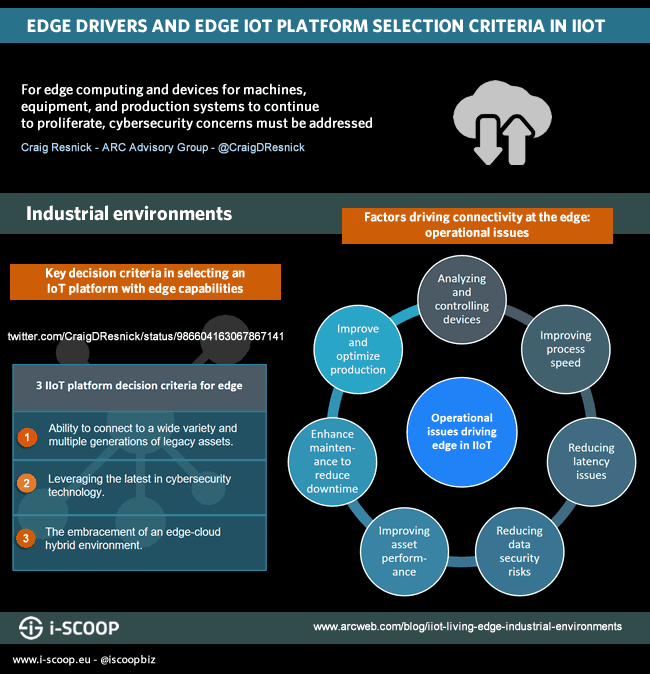
The IoT edge software and hardware challenge when selecting a vendor
As mentioned in a previous article on the IoT edge platform market MachNation, which defines the edge as a distributed technology and processing architecture that brings certain computational and analytics capabilities near the point of data generation, looked into the IoT edge software market.
When announcing its IoT Edge ScoreCard for 2018 the company forecasted a pretty strong growth of IoT edge revenue and looked at a few leading IoT edge software (and some also hardware) vendors: ADLINK, Amazon, CalAmp, Cisco, ClearBlade, Dell, FogHorn Systems, Huawei, Litmus Automation, Microsoft, MultiTech, Nebbiolo Technologies, SAP, Siemens, Software AG’s Cumulocity IoT and Telit.
MachNation CTO Dima Tokar also pointed out that roundabout 90 percent of edge complexity is software related. Many vendors offer hardware (the first mentioned in the mentioned list of edge software vendors, ADLINK, for instance has a broad range of hardware for the edge and specialized hardware for several industries and of course there are more), that adequately supports many IoT solutions Tokar said, adding that the quality and sophistication of the related edge software is a true differentiator.
Later, in April 17 2018, MachNation, known for its MIT-E IoT platform test and comparison lab released the “IoT Edge Market Report: 2017-2018” building upon the mentioned 2018 IoT Edge ScoreCard.
The graphic below shows how edge vendors ‘overwhelmingly’ use their own IoT gateways which makes it easier to deploy an IoT edge platform than on a legacy, industrial connected asset. However, for buyers of IoT platforms easier of course doesn’t necessarily mean better in this scope.
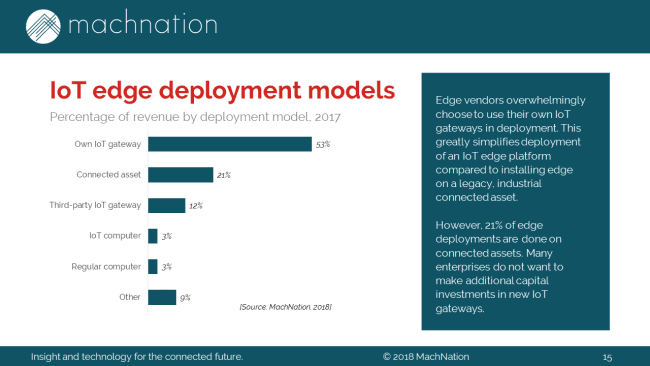
Reminding what Craig Resnick said: “the ability of the platforms to connect to a wide variety and multiple generations of legacy assets”. And 21 percent of edge deployments are done on connected assets, followed by third-party IoT gateways.
Again interoperability and openness come to mind from an IoT platform decision criteria perspective. As MachNation says: organizations aren’t really that interested in making additional capital investments in new IoT gateways.
Up to vendors to be creative as who still wants CapEx in the longer run? It’s not a coincidence that some IoT platform vendors also come up with alternative forms of financing and even insuring IoT projects as, for example, the people of Industry 4.0 platform relayr do. Moreover, as a lot of complexity is software-related and as in the end the as-a-Service approach penetrates everywhere in a world “eaten by software” the hardware picture will change.
The critical capabilities in the best IoT edge platforms
Back to our IoT platform selection criteria. MachNation was kind enough to send a paper which you might have read or seen elsewhere in which it mentions IoT platform test lab data for industrial enterprises and contains five capabilities IoT edge platforms for enterprise should have.
Or in other words: five capabilities buyers who are seeking the best IoT platform for their needs might add to their list of IoT selection criteria. They are depicted below.
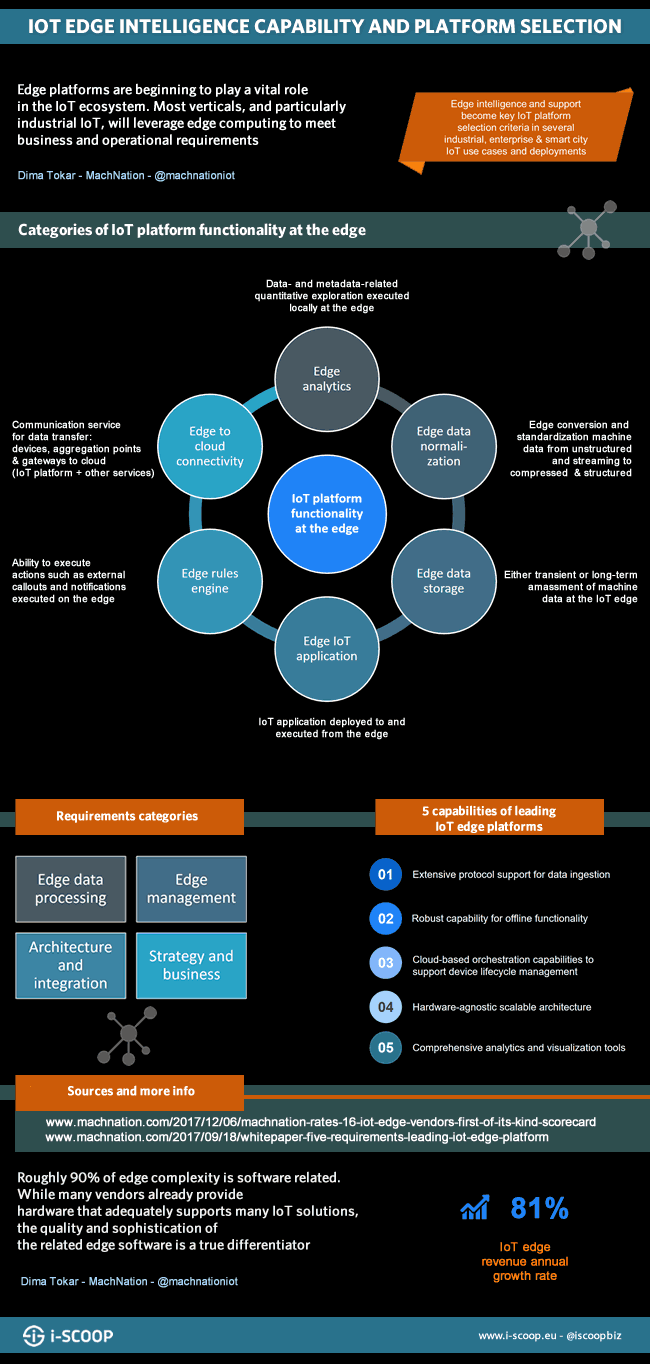
Protocol support for data ingestion
The first IoT edge platform capability, extensive protocol support for data ingestion, means selecting the best IoT platforms in terms of a broad mix of protocols for data ingestion and of course for the key overall IoT platform decision criterion of security.
As we’re in industrial IoT and the integration of IT and OT do think about both older and newer deployment staples. MachNation also states the protocol support by the platform should be modular, enable customization of asset communications and, on the mentioned security front, encryption, authentication and data protection functionality is key.
Robust capability for offline functionality
The second IoT edge platform capability, reminds us of the dimension of the de facto hybrid cloud and edge environment. One of the reasons which is sometimes cited to leverage edge computing is related with the uptime and downtime of cloud systems.
Offline capabilities in edge systems are needed in four functional areas according to MachNation:
- Data normalization to successfully clean noisy sensor data.
- Storage to support intermittent, unreliable or limited connectivity between the edge and the cloud.
- A flexible event processing engine at the edge making it possible to generate insight from machine data.
- Integration with systems including ERP (evolving to i-ERP), MES (manufacturing execution systems), inventory management and supply chain management to help ensure business continuity and access to real-time machine data.
Cloud-based orchestration capabilities
The cloud orchestration capability to support device lifecycle management is related with IoT device provisioning/onboarding, monitoring and updating whereby we’re in the IoT device management sphere but of course also in the industrial IoT security sphere with certificates, key and authentication.
API-based interactions need to allow a device to be preloaded with such certificates and keys and also with edge applications and an initial configuration MachNation emphasizes. Moreover, edge platforms should be capable to monitor the device using a stream of machine and operational data that can be selectively synced with cloud instances and should push updates over-the-air to edge applications, the platform itself, the gateway OS, device drivers and devices connected to a gateway.
Hardware-agnostic and scalable architecture; comprehensive analytics/visualization tools
The hardware-agnostic dimension points, among others, to the previously mentioned needs of buyers to have their IoT platforms run a various IoT gateways and other devices which are used, depending on the IoT project and use case (there is more but we don’t want to become too technical) while in the scope of the comprehensive analytics and visualization tools capability MachNation says that enterprises must choose IoT platforms that offer out-of-the-box capabilities to aggregate data, run common statistical analyses and visualize data.
There is more in the paper, you can check out the sites of various IoT edge software providers such as the ones mentioned in the IoT Edge ScoreCard for 2018, it’s important to note that, on top of pure IoT platforms, it’s also key to check IoT-enabled platforms for your specific industry and use cases whereby the list of those with edge capabilities becomes quite a bit longer and in the end it is still a business decision that requires more than features.
Yet, of course performance and actual test results do have an impact on the business and the users once you have selected your ‘best IoT platform(s)’.
Top image: Shutterstock – Copyright: g-stockstudio – All other images are the property of their respective mentioned owners.

